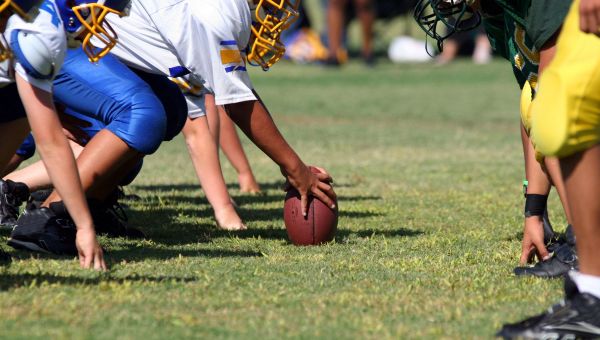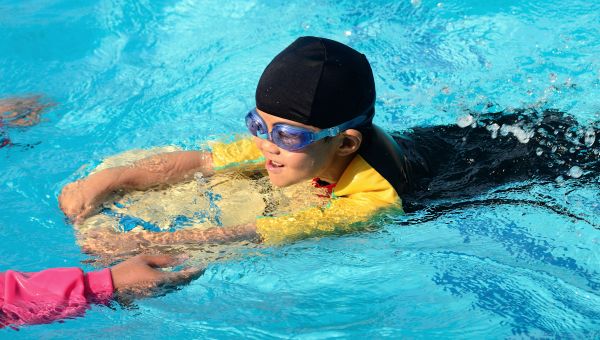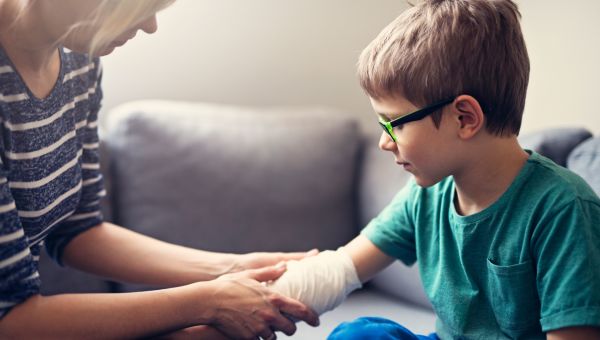These injuries send 9.2 million kids to the hospital each year
Burns, car crashes, concussions and other injuries contribute most to child and teen deaths rates.

The number one cause of death in American kids is unintentional injuries, including drowning, falls and poisoning. On average, 12,175 children ages 0 to 19 die every year in the US from an unintentional injury. To make matters worse, 9.2 million others go to emergency rooms and centers for nonfatal injuries, according to the Centers for Disease Control and Prevention (CDC).
While you probably can’t be with your child all day, every day, there are some ways you can prepare your child for an emergency and prevent injuries from occurring.
Sports medicine specialist Jon Schultz, MD, of Overland Park Regional Medical Center in Kansas City, Missouri discusses some of the most common injuries among infants, toddlers, school-aged kids and teens, plus how you can protect your child.

Burns
Over 300 kids age 19 and under are treated in emergency rooms every day for burn-related injuries. Of those, unfortunately, two of them die.
Young children are more prone to scald burns, or burns related to hot liquids and steam, while older children are prone to flame burns, or burns related to fire.
Here are some fire-safety tips:
- Practice safe kitchen habits: Never leave food that’s cooking on the stove unattended. It’s best to keep kids away from stoves, ovens and microwaves, especially when you’re not supervising them.
- Take a look at your water heater settings: Anything above 120 degrees Fahrenheit is going to be too hot for most anyone. Be sure your heater is set somewhere under 120 degrees and that you periodically check your taps to be sure the water isn’t too hot.
- Set up smoke alarms: Be sure that you have a least one smoke detector, or one near each bedroom that’s properly installed. You’ll want to check them once a month to make sure they’re working.
- Develop an escape plan: In case there is a house fire, make sure your children are involved in your family’s fire escape plan. Keep in mind that you’ll want to find two ways out of each room and to establish a meeting place outside in case of an emergency.

Concussions
Every year, 1.1 to 1.9 million US children ages 18 and under get sports or recreation-related concussions. A concussion is a type of head injury that temporarily affects brain function, and often occurs when there is trauma to the head—specifically, when the head and brain are jolted back and forth.
Here are some ways Schultz recommends to prevent these types of life-threatening injuries:
- Practice proper technique: If your child plays a sport, make sure they work with a trainer or coach to learn the proper form for things like tackling and heading. “Practicing proper heading technique in sports, like soccer, can lessen the risk of concussions,” says Schultz. Sporting rules, like hitting a defenseless player, have definitely helped, but it doesn’t hurt to make sure your child understands the proper way to play to prevent injuries.
- Wear the right gear: Almost all sports require that kids wear some type of protection like shoulder pads or helmets, but it’s important that your child’s gear fits properly. If it doesn’t, it’s probably not going to protect them as well. You may have to replace certain types of gear each season, especially if your child has out-grown it or it’s worn out. Watch out for things like broken buckles and worn padding.
- Be aware of the signs: It’s not always easy to recognize the signs of a concussion, but if you and your child are familiar with common signs, that may help. “If an athlete suspects he or she might have a concussion, they should be honest with parents, athletic trainers and coaches in order to prevent a prolonged recovery from a concussion,” says Schultz. Some symptoms may gradually worsen over time and may not show up until days later: Here are some signs to watch out for:
- Headache
- Nausea or vomiting
- Dizziness
- Trouble with balance
- Irritability
- Unhappiness
- Exhaustion
- Anxiety
- Trouble falling asleep or staying asleep
If your child is showing signs, head to the emergency room so a doctor can perform a physical exam and test nervous system functioning with things like balance, coordination, nerve function and reflex assessments. You should also pull your child out of the activity or practice right away.

Drowning
Water safety is a huge concern for parents. Drowning is a leading cause of injury death for children ages 0 to 14, and three children in the US die every day from drowning. That makes it the most common cause of death, besides birth defects, in children ages 1 to 4.
Beaches, lakes and pools are great places to vacation, but it’s important that your child knows how to swim or has the right gear on if they’re going in. Here are some tips to keep in mind if your child is going to be around water:
- Install a fence: If you have a pool in your backyard and you have young children, you’ll want to be sure you have a four-sided isolation fence with a self-closing and self-latching gate. The fencing will ensure that your young children can’t get in when you aren’t supervising. Many states and communities require this type of fencing for anyone who does have a pool, so you’ll want to check with local government or state building commission for specific guidelines.
- Always wear a life jacket: Even if your child knows how to swim, it’s still best to have them wear a lifejacket anytime they’re around natural bodies of water, like lakes, rivers or oceans.
- Always be on the lookout: Drowning can happen very quickly and quietly. Whether your child is taking a bath, swimming in the pool or taking the boogie board out into the ocean, it’s crucial that you supervise them.
- Know the signs: You’ll be able to recognize the signs of drowning so you can help them—or get help— if needed. Here are the signs someone may be drowning:
- Head is below surface of the water and mouth is level with the water
- Head is titled back or forward and mouth is open
- Glassy or closed eyes
- Hair is in front of face
- Legs are vertical
- Gasping or hyperventilating
- Attempting to swim in one direction, but not getting anywhere
- Playing in the bathtub, but suddenly gets quiet
If you think your child is drowning:
- Get them out of the water as soon as you can.
- If they’re not breathing, give them CPR immediately and keep going until they are breathing again or until the paramedics arrive.
- If there is someone around, have them call 911 or look for medical help. If not, once your child starts breathing again, call 911.

Poisoning
Children are prone to eating and drinking everything they see, so it’s no wonder that you’ll have to keep an eye out for medications, household cleaning or laundry products, pesticides, chemicals or makeup that they could get their hands on.
If your child swallows or inhales some type of substance that is poisonous or gets anything poisonous on their skin or in their eyes, make sure to get the item out of your child’s reach. If it’s in their mouth, take it out, but don’t make them vomit, since this can cause more damage. Start CPR or other treatment if appropriate and call 911. You can call Poison Control at 1-800-222-1222 for further direction, too.
For irritants on the skin, take off their clothes and rinse the area with room temperature water for 15 minutes or more. If your child has inhaled something poisonous, make sure they start breathing in clean air immediately. It’s always best to follow up with your pediatrician to get advice about the best next steps.
To prevent your child from getting their hands on harmful substances, keep medications and cleaning supplies up and out of their reach. Lock up cabinets and drawers with child-proof latches to prevent them from getting into harmful substances.

Car-related injuries
Automobile accidents are the leading cause of death among teens, and even though parents can only control so much, they are an important deterrent to kids making bad decisions in cars, says Schultz. In 2015, six teenagers between the age of 16 and 19 died every day from injuries related to car accidents.
Texting and driving, carrying lots of passengers, speeding, late night driving, drunk driving and inexperience all contribute to car accidents among teens.
Before your teen starts driving, you’ll want to establish clear boundaries. Then, be consistent with discipline. “As parents, we are usually the first and most influential person in teenagers’ lives to affect change,” says Schultz.
Here are some ways you can encourage your child to practice safe driving:
- Practice, practice, practice: You’ll want to be sure that you spend enough time in the car with them prior to them getting on the road by themselves. Driver’s education courses are great teaching tools, too. Not sure where to begin? Check out these tips from the Department of Motor Vehicles.
- Wearing seatbelts is the law, but it’s important that you establish this as a rule when your child starts driving.
- Drinking and driving is against the law, too, so emphasize that it’s never acceptable. They should call a parent or car service if they’ve been drinking or are under the influence of any substance.
- Always set a good example. You don’t want your teen to drive under the influence, speed or text while driving, so you’ll want to refrain from doing those things while you’re driving, too.
To enforce the driving rules, you can create a Parent-Teen Driving Agreement when your child first starts driving. The agreement can include things like: curfew, number of friends allowed in the car, texting and driving rules, among many other things.

Breaks, sprains and strains
Kids are adventurous—and it’s highly likely they’re going want to climb trees, run around the neighborhood, play sports and goof around. As parents, you want them to have fun and get some exercise.
High energy levels can often lead to breaks, sprains and strains, but the good news is, they are very treatable (and some are even preventable).
Not sure how to tell which is which? Signs of a break include hearing or feeling a bone snap, difficulty moving the injured body part or sensitivity when touched.
Sprains include anytime a ligament is torn or overstretched; strains involve an overstretched or torn muscle or tendon. Both can cause swelling, pain and bruising, but unless severe, most can be treated at home.
Like concussion prevention, it’s important that your child learn the proper technique when playing sports. Working with a coach or trainer at the beginning to learn techniques can help prevent unnecessary injuries. And wearing helmets, elbow pads, wrist guards and knee pads when your child is skateboarding, riding a bike or rollerblading can help prevent injuries from being serious when they do fall.
If you suspect your child has a break, do not move them if the injury is related to the neck or back, and if the bone is protruding, call 911. For breaks to other areas of the body, keep the limb in whatever position you find it in and try to make a splint using anything that can extend around the joints and above the break until you can get to the doctor for an x-ray. Newspapers or cardboard can be used, and old rags, towels or pillow cases can pad the area in between.
If it’s a strain, avoid applying heat, since that can increase swelling. Typical treatment for a strain or sprain is RICE:
- Rest: Take it easy for 24 to 48 hours or more.
- Ice: Apply an ice pack or cold compress for 10 to 15 minutes once every few hours for up to two days.
- Compression: Wrap bandage around the area for at least 2 days.
- Elevate: Try keeping the injured body part above the heart to prevent swelling.
Over-the-counter pain medications may be recommended for a variety of injuries, too.
More On


video

article

slideshow


video


video
